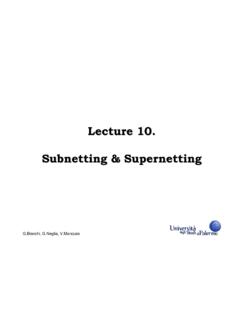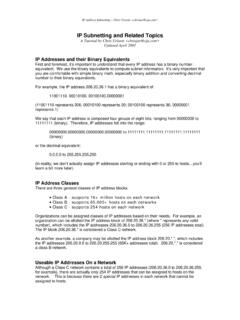Transcription of Lecture 10. Subnetting & Supernetting - Inria
1 , , & , , Subnetting Variable Length subnet Mask (VLSM) Supernetting Classless Inter-Domain Routing (CIDR) , , org: N x class C? Class B?medium org: N x class C? Class B? Class C addresses: Undersized (254 hosts) Class B addresses: Much more than enough (65534 hosts) N x class C: Unwise: exponential growth of routing tables Result: Class B addresses were largely HopR2 Routing aftermath: 10 bit class C design would have been much , , for Need for subnettingsubnetting Net_id-Host_id: place host_id on physical network hosts on a same physical network????- performance?- management?CLASS B:From: , , : further hierarchy levelIdea: further hierarchy level subdivide a network in several subnetworks each subnet = a physical network (Ethernet, FDDI, , ATM, Frame Relay, )Sub-NetRouter Host third byte to identify subnet : (or may not!)
2 Class B network: , , creation and managementSubnet creation and managementInternetInterNICP rivate Network me a class B, for you! for local administrator: flexibility to create new networks without asking InterNICnew classful for Internet: Route flapping in the private domain do not affect InternetOne single entry in core router tables address all , , B address exampleClass B address example1 NET ID (14bit)HOST ID (16-n bit)0 subnet ID (n bit)1 NET ID (14bit)HOST ID (16 bit)0network prefix(network address)Extended network prefix( subnet address) , , & MaskMask Host IP Class B - network subnet Mask Longer than natural class mask.
3 Length set by administrator Tells where the boundary network-host really Example: class B address with 5 bits subnet_id subnet mask = /21 /prefix-length notation subnet mask = (dot decimal notation) = net_id = extended network address (net_id+subnet_id) To avoid ambiguity: , , class B Typical class B subnettingsubnetting Class B address = /16 network prefix network address = natural mask = Subnetted with /24 network prefix1 NET ID (14bit)HOST ID (8 bit)0 subnet ID (8 bit) subnet mask subnet ID = third number in dotted notation technical reasonsto use /24 subnets, but convenient for humans( subnet boundary clearly visible in dotted notation) , , : Remember: subnettingsubnettingis arbitrary!
4 Is arbitrary!Example: Example: subnettingsubnettingClass C AddressClass C Address1 NET ID (21bit)HOST ID (8 bit)10 Class C/24 ID (21bit)Host id(5bit)10 subnet (3 bit)Base # # # # # # # # : maximum 30(25-2) hosts attachable to each , , Possible netmasknetmaskvaluesvalues11111111= 25511111110= 25411111100= 25211111000= 24811110000= 24011100000= 22411000000= 19210000000= , , : route : route C address;Outside private domain routed with mask private domain, administrator has set netmask /2940110011000100100networkhostHence, route to subnet address and then to host id, computed , , 2nd example 2nd example Core routers unaware of Subnetting Core routers unaware of Subnetting route via class maskroute via class routing tables in the Internet: route according to net_id Use natural class maskNet = subnet mask = Corporate routers & hosts: Route according to subnet_id Need to KNOW subnet , , Classful routing.
5 All necessary informationincluded in Ipaddr subnet routing Specific subnet mask(set by admin) requireddestNext HopSubnet TableNet = ; subnet mask other be quite a complexRouting will help (later) , , (problem)Example (problem)ACBMath dept22 hostsComputation28 hostphysics10 hostLink-1 Link-2algebra12 , , (solution?)Example (solution?)ACBMath to 30 hosts (97-126) to 30 hosts(65-94) to 30 hosts(33-62) networkWhere are the errors? to 30 hosts(161-190) , , (solution!)Example (solution!)ACBMath to 29 hosts (97-126) to 29 hosts(65-94) to 29 hosts(33-62) to 28 hosts(161-190) subnet mask: /27 , , Length subnet MaskVariable Length subnet MaskRFC 1009 (1987)RFC 1009 (1987) , , Length subnet MaskVariable Length subnet Mask allows more than one subnet mask in the same network A) more efficient use of organization s IP address space Subnets may significantly vary in relative size (computer room = 200 hosts, secretary = 4 ) consider a 4 host network with mask : wastes 250 IP addresses!
6 B) allows route aggregation, thus reducing routing information needed Needs further support by routing protocol RIP1 doesn t support , , typical problemA typical problemACBpc-net100 hostws-net20 hostx-net-120 hostx-net-210 hostLink-1 Link-2 Link-3100+20+20+10 = 150 total hosts: 1 class C enough (including growth projections). 7 subnets (4 LANS + 3 point to point links): 3 bit subnet ID (= up to 8 subnets)BUT then max 30 host per subnet : no way to accommodate pc-net!! , , without VLSMS olution without VLSM need 2 class C address!need 2 class C address! (0-127, 126 host) (128-255, 126 host) (0-31, 30 host) (32-63, 30 host) , , Recursive address space aggregation!
7 First, divide network in subnets then, SOME subnets further divided into sub-subnets then, some sub-subnets further etc(pc-net) (up to 30 hosts) (up to 30 hosts) (up to 30 hosts) (up to 30 hosts) (up to 254 hosts) (up to 126 hosts) (up to 126 hosts)(ws-net)(x1-net)(available) (up to 14 hosts) (up to 14 hosts)(x2-net) (ptp) (ptp) (ptp) (avail) , , solution with VLSMF inal solution with VLSM1 C address is enough1 C address is (0-127, 126 host) (128-159, 30 host) (160-191, 30 host) (192-207, 14 host) , , pie for our pie for our 208-211 Link2 212-215 Link3 216-219 Available forfurther , , for VLSM support (1)Requirements for VLSM support (1) Routing tables: need to specify extended network prefix information ( subnet mask) per each entry Routing protocol: must carry extended network prefix information with each route advertisementNew route advertise + mask (or prefix len) /20 Without this feature: manually compiled tables (!)
8 !! Human error!!!)VLSM bottomline: need to use more complex routing protocols ( OSPF) even for small org , , (0-127, 126 host) (128-159, 30 host) (160-191, 30 host) (192-207, 14 host) tables for previous exampleRouting tables for previous C , , engineeringVLSM engineering VLSM is a hierarchical subnet address assignment BUT does not necessarily implies, by itself, a hierarchical routing!! Effective designs combine: address space reduction with topologically significant address assignment Substantial reduction of routing table sizes Multiple route , , engineeringVLSM engineering VLSM is a hierarchical subnet address assignment BUT does not necessarily implies, by itself, a hierarchical routing!
9 ! Effective designs combine: address space reduction with topologically significant address assignment Substantial reduction of routing table sizes Multiple route , , example 1 Complete example 1 Acquistando uno spazio di indirizzi il pi piccolo possibile, da un provider che gestisce lo spazio /16, -Si divida in sottoreti la rete illustrata in figura in modo da soddisfare alle capacit richieste-Si assegnino indirizzi IP alle interfacce dei router-Si mostri la routing table del router REdificio A10 hostsEdificio B110 hostsEdificio C55 hostsEdificio E12 hostsEdificio D11 hostsnetworkmaskdestRouter REdificio A10 hostsEdificio B110 hostsEdificio C55 hostsEdificio E12 hostsEdificio D11 hostsnetworkmaskdestEdificio A110 hostsEdificio B55 hostsEdificio C10 hostsEdificio E12 hostsEdificio D11 hostsnetworkmaskdestRouter.
10 Solution no route aggregationno route aggregationEdificio A110 hostsEdificio B55 hostsEdificio C10 hostsEdificio E12 hostsEdificio D11 hostsRouter R sufficiente uno /24, es: /24 Una soluzione possibile, con massima aggregazionedei route, illustrata in figura (si assume cheil routing esterno alla rete avvenga tramitel interfaccia remota ) , , Solution finalfinalEdificio A110 hostsEdificio B55 hostsEdificio C10 hostsEdificio E12 hostsEdificio D11 hostsRouter R sufficiente uno /24, es: /24 Una soluzione possibile, con massima aggregazionedei route, illustrata in figura (si assume cheil routing esterno alla rete avvenga tramitel interfaccia remota )











